warning CADILLAC XLR V 2007 1.G Repair Manual
[x] Cancel search | Manufacturer: CADILLAC, Model Year: 2007, Model line: XLR V, Model: CADILLAC XLR V 2007 1.GPages: 512, PDF Size: 3.84 MB
Page 431 of 512
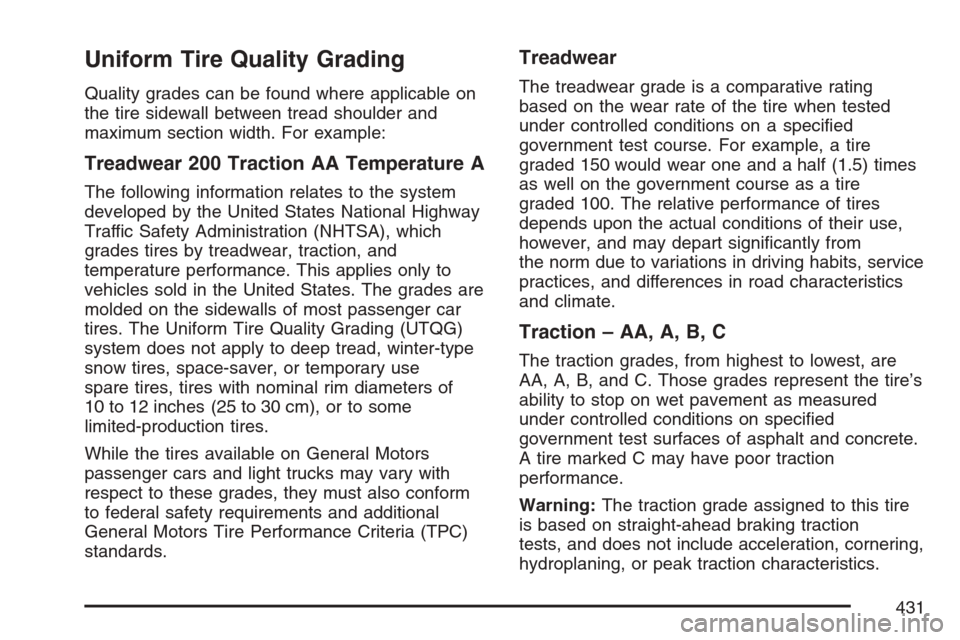
Uniform Tire Quality Grading
Quality grades can be found where applicable on
the tire sidewall between tread shoulder and
maximum section width. For example:
Treadwear 200 Traction AA Temperature A
The following information relates to the system
developed by the United States National Highway
Traffic Safety Administration (NHTSA), which
grades tires by treadwear, traction, and
temperature performance. This applies only to
vehicles sold in the United States. The grades are
molded on the sidewalls of most passenger car
tires. The Uniform Tire Quality Grading (UTQG)
system does not apply to deep tread, winter-type
snow tires, space-saver, or temporary use
spare tires, tires with nominal rim diameters of
10 to 12 inches (25 to 30 cm), or to some
limited-production tires.
While the tires available on General Motors
passenger cars and light trucks may vary with
respect to these grades, they must also conform
to federal safety requirements and additional
General Motors Tire Performance Criteria (TPC)
standards.
Treadwear
The treadwear grade is a comparative rating
based on the wear rate of the tire when tested
under controlled conditions on a speci�ed
government test course. For example, a tire
graded 150 would wear one and a half (1.5) times
as well on the government course as a tire
graded 100. The relative performance of tires
depends upon the actual conditions of their use,
however, and may depart signi�cantly from
the norm due to variations in driving habits, service
practices, and differences in road characteristics
and climate.
Traction – AA, A, B, C
The traction grades, from highest to lowest, are
AA, A, B, and C. Those grades represent the tire’s
ability to stop on wet pavement as measured
under controlled conditions on speci�ed
government test surfaces of asphalt and concrete.
A tire marked C may have poor traction
performance.
Warning:The traction grade assigned to this tire
is based on straight-ahead braking traction
tests, and does not include acceleration, cornering,
hydroplaning, or peak traction characteristics.
431
Page 432 of 512
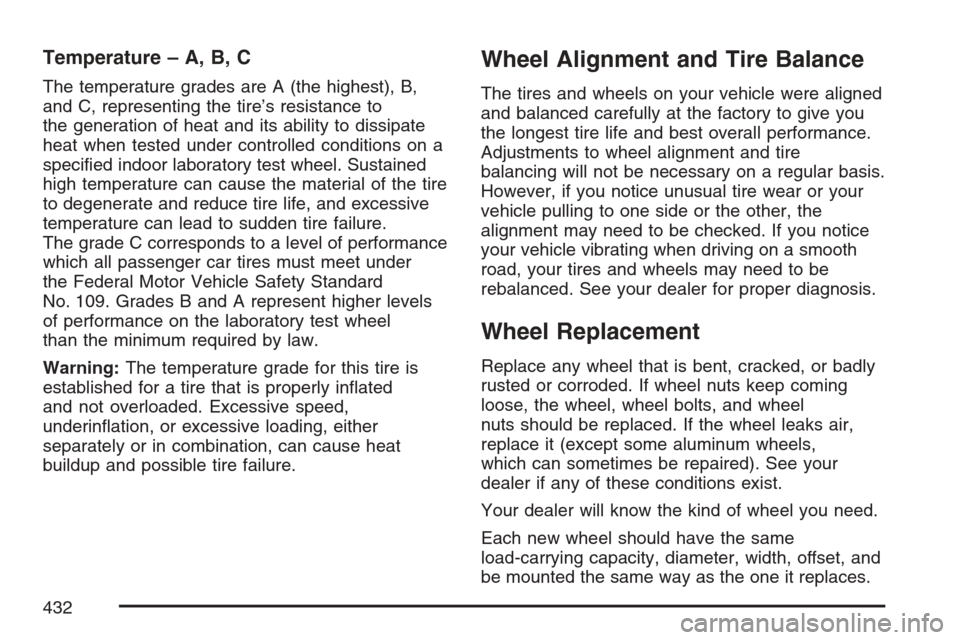
Temperature – A, B, C
The temperature grades are A (the highest), B,
and C, representing the tire’s resistance to
the generation of heat and its ability to dissipate
heat when tested under controlled conditions on a
speci�ed indoor laboratory test wheel. Sustained
high temperature can cause the material of the tire
to degenerate and reduce tire life, and excessive
temperature can lead to sudden tire failure.
The grade C corresponds to a level of performance
which all passenger car tires must meet under
the Federal Motor Vehicle Safety Standard
No. 109. Grades B and A represent higher levels
of performance on the laboratory test wheel
than the minimum required by law.
Warning:The temperature grade for this tire is
established for a tire that is properly in�ated
and not overloaded. Excessive speed,
underin�ation, or excessive loading, either
separately or in combination, can cause heat
buildup and possible tire failure.
Wheel Alignment and Tire Balance
The tires and wheels on your vehicle were aligned
and balanced carefully at the factory to give you
the longest tire life and best overall performance.
Adjustments to wheel alignment and tire
balancing will not be necessary on a regular basis.
However, if you notice unusual tire wear or your
vehicle pulling to one side or the other, the
alignment may need to be checked. If you notice
your vehicle vibrating when driving on a smooth
road, your tires and wheels may need to be
rebalanced. See your dealer for proper diagnosis.
Wheel Replacement
Replace any wheel that is bent, cracked, or badly
rusted or corroded. If wheel nuts keep coming
loose, the wheel, wheel bolts, and wheel
nuts should be replaced. If the wheel leaks air,
replace it (except some aluminum wheels,
which can sometimes be repaired). See your
dealer if any of these conditions exist.
Your dealer will know the kind of wheel you need.
Each new wheel should have the same
load-carrying capacity, diameter, width, offset, and
be mounted the same way as the one it replaces.
432
Page 440 of 512
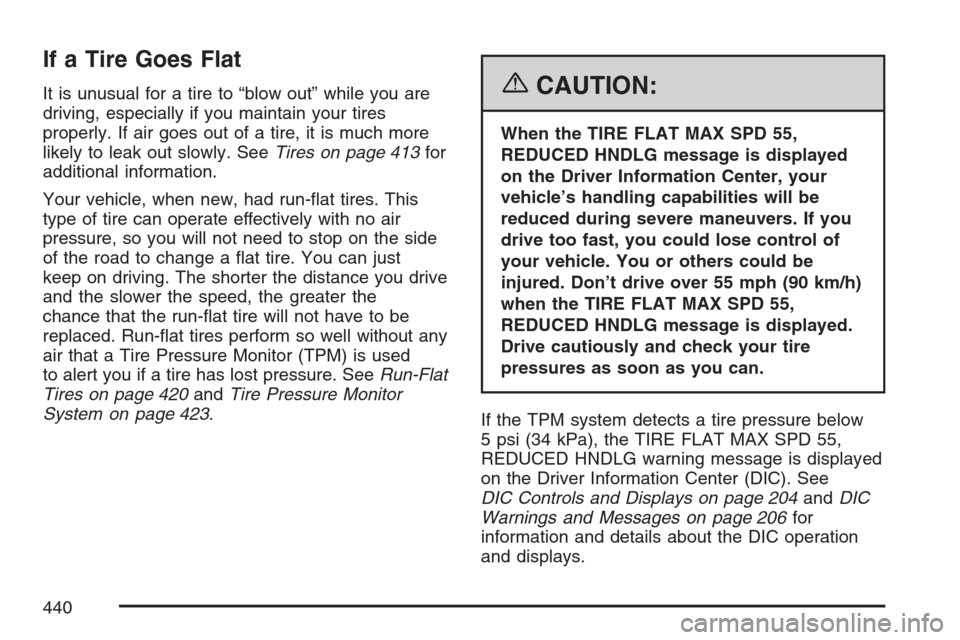
If a Tire Goes Flat
It is unusual for a tire to “blow out” while you are
driving, especially if you maintain your tires
properly. If air goes out of a tire, it is much more
likely to leak out slowly. SeeTires on page 413for
additional information.
Your vehicle, when new, had run-�at tires. This
type of tire can operate effectively with no air
pressure, so you will not need to stop on the side
of the road to change a �at tire. You can just
keep on driving. The shorter the distance you drive
and the slower the speed, the greater the
chance that the run-�at tire will not have to be
replaced. Run-�at tires perform so well without any
air that a Tire Pressure Monitor (TPM) is used
to alert you if a tire has lost pressure. SeeRun-Flat
Tires on page 420andTire Pressure Monitor
System on page 423.{CAUTION:
When the TIRE FLAT MAX SPD 55,
REDUCED HNDLG message is displayed
on the Driver Information Center, your
vehicle’s handling capabilities will be
reduced during severe maneuvers. If you
drive too fast, you could lose control of
your vehicle. You or others could be
injured. Don’t drive over 55 mph (90 km/h)
when the TIRE FLAT MAX SPD 55,
REDUCED HNDLG message is displayed.
Drive cautiously and check your tire
pressures as soon as you can.
If the TPM system detects a tire pressure below
5 psi (34 kPa), the TIRE FLAT MAX SPD 55,
REDUCED HNDLG warning message is displayed
on the Driver Information Center (DIC). See
DIC Controls and Displays on page 204andDIC
Warnings and Messages on page 206for
information and details about the DIC operation
and displays.
440
Page 499 of 512
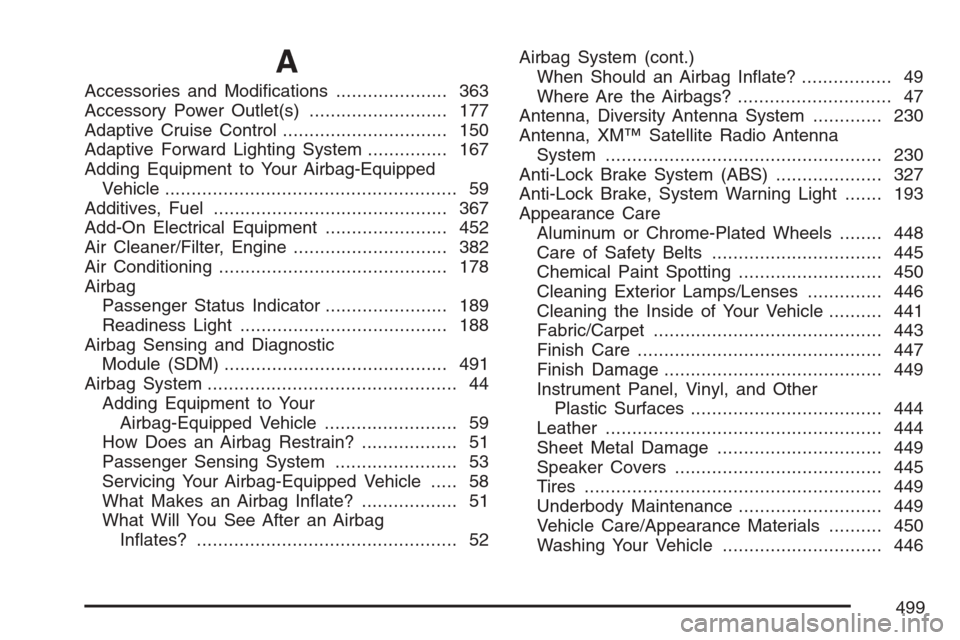
A
Accessories and Modi�cations..................... 363
Accessory Power Outlet(s).......................... 177
Adaptive Cruise Control............................... 150
Adaptive Forward Lighting System............... 167
Adding Equipment to Your Airbag-Equipped
Vehicle....................................................... 59
Additives, Fuel............................................ 367
Add-On Electrical Equipment....................... 452
Air Cleaner/Filter, Engine............................. 382
Air Conditioning........................................... 178
Airbag
Passenger Status Indicator....................... 189
Readiness Light....................................... 188
Airbag Sensing and Diagnostic
Module (SDM).......................................... 491
Airbag System............................................... 44
Adding Equipment to Your
Airbag-Equipped Vehicle......................... 59
How Does an Airbag Restrain?.................. 51
Passenger Sensing System....................... 53
Servicing Your Airbag-Equipped Vehicle..... 58
What Makes an Airbag In�ate?.................. 51
What Will You See After an Airbag
In�ates?................................................. 52Airbag System (cont.)
When Should an Airbag In�ate?................. 49
Where Are the Airbags?............................. 47
Antenna, Diversity Antenna System............. 230
Antenna, XM™ Satellite Radio Antenna
System.................................................... 230
Anti-Lock Brake System (ABS).................... 327
Anti-Lock Brake, System Warning Light....... 193
Appearance Care
Aluminum or Chrome-Plated Wheels........ 448
Care of Safety Belts................................ 445
Chemical Paint Spotting........................... 450
Cleaning Exterior Lamps/Lenses.............. 446
Cleaning the Inside of Your Vehicle.......... 441
Fabric/Carpet........................................... 443
Finish Care.............................................. 447
Finish Damage......................................... 449
Instrument Panel, Vinyl, and Other
Plastic Surfaces.................................... 444
Leather.................................................... 444
Sheet Metal Damage............................... 449
Speaker Covers....................................... 445
Tires........................................................ 449
Underbody Maintenance........................... 449
Vehicle Care/Appearance Materials.......... 450
Washing Your Vehicle .............................. 446
499
Page 500 of 512
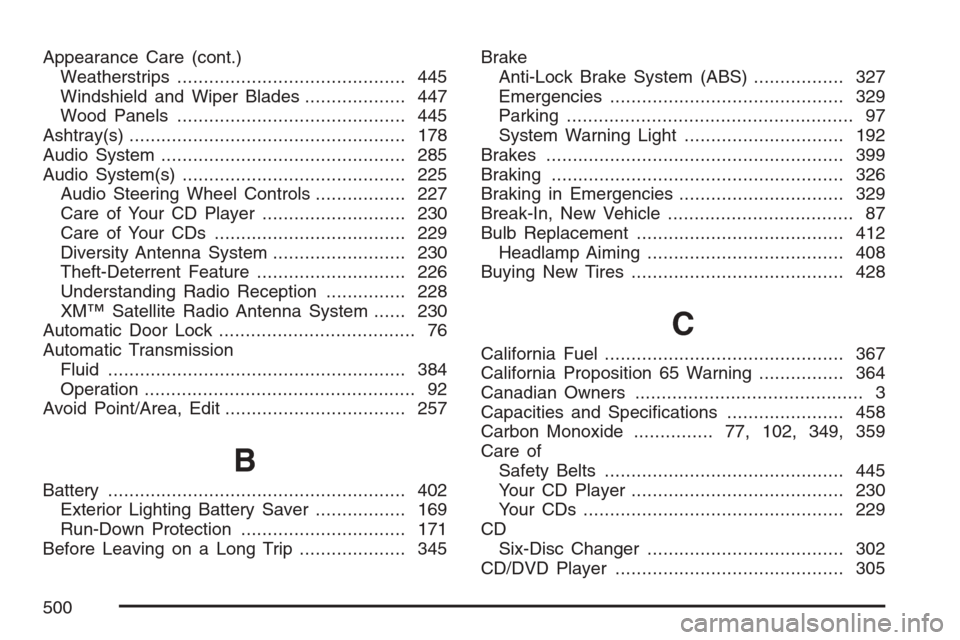
Appearance Care (cont.)
Weatherstrips........................................... 445
Windshield and Wiper Blades................... 447
Wood Panels........................................... 445
Ashtray(s).................................................... 178
Audio System.............................................. 285
Audio System(s).......................................... 225
Audio Steering Wheel Controls................. 227
Care of Your CD Player........................... 230
Care of Your CDs.................................... 229
Diversity Antenna System......................... 230
Theft-Deterrent Feature............................ 226
Understanding Radio Reception............... 228
XM™ Satellite Radio Antenna System...... 230
Automatic Door Lock..................................... 76
Automatic Transmission
Fluid........................................................ 384
Operation................................................... 92
Avoid Point/Area, Edit.................................. 257
B
Battery........................................................ 402
Exterior Lighting Battery Saver................. 169
Run-Down Protection............................... 171
Before Leaving on a Long Trip.................... 345Brake
Anti-Lock Brake System (ABS)................. 327
Emergencies............................................ 329
Parking...................................................... 97
System Warning Light.............................. 192
Brakes........................................................ 399
Braking....................................................... 326
Braking in Emergencies............................... 329
Break-In, New Vehicle................................... 87
Bulb Replacement....................................... 412
Headlamp Aiming..................................... 408
Buying New Tires........................................ 428
C
California Fuel............................................. 367
California Proposition 65 Warning................ 364
Canadian Owners........................................... 3
Capacities and Speci�cations...................... 458
Carbon Monoxide............... 77,102, 349, 359
Care of
Safety Belts............................................. 445
Your CD Player........................................ 230
Your CDs ................................................. 229
CD
Six-Disc Changer..................................... 302
CD/DVD Player........................................... 305
500
Page 502 of 512

Customer Assistance Information (cont.)
Customer Satisfaction Procedure.............. 482
GM Mobility Reimbursement Program...... 486
Reporting Safety Defects to
General Motors..................................... 497
Reporting Safety Defects to the
Canadian Government.......................... 496
Reporting Safety Defects to the
United States Government.................... 496
Roadside Service..................................... 487
Service Publications Ordering
Information........................................... 497
D
Database Coverage Explanations................ 284
Daytime Running Lamps............................. 166
Defensive Driving........................................ 322
Diversity Antenna System............................ 230
Doing Your Own Service Work.................... 364
Door
Automatic Door Lock................................. 76
Locks......................................................... 73
Power Door Locks..................................... 75
Programmable Automatic Door Unlock....... 76Driver
Position, Safety Belt................................... 18
Driver Information Center (DIC)................... 203
DIC Controls and Displays....................... 204
DIC Vehicle Personalization..................... 220
DIC Warnings and Messages................... 206
Other Messages....................................... 219
Driving
At Night................................................... 339
City.......................................................... 343
Defensive................................................. 322
Drunken................................................... 323
Freeway................................................... 344
Hill and Mountain Roads.......................... 347
In Rain and on Wet Roads...................... 340
Rocking Your Vehicle to Get it Out.......... 354
Winter...................................................... 349
Dual Climate Control System....................... 178
DVD, CD Player.......................................... 305
502
Page 503 of 512
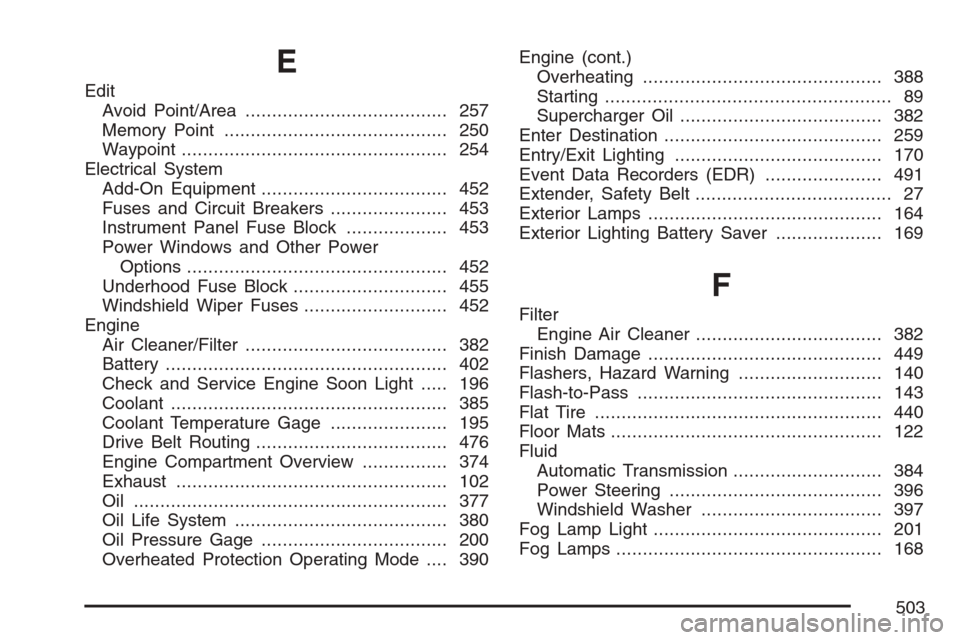
E
Edit
Avoid Point/Area...................................... 257
Memory Point.......................................... 250
Waypoint.................................................. 254
Electrical System
Add-On Equipment................................... 452
Fuses and Circuit Breakers...................... 453
Instrument Panel Fuse Block................... 453
Power Windows and Other Power
Options................................................. 452
Underhood Fuse Block............................. 455
Windshield Wiper Fuses........................... 452
Engine
Air Cleaner/Filter...................................... 382
Battery..................................................... 402
Check and Service Engine Soon Light..... 196
Coolant.................................................... 385
Coolant Temperature Gage...................... 195
Drive Belt Routing.................................... 476
Engine Compartment Overview................ 374
Exhaust................................................... 102
Oil ........................................................... 377
Oil Life System........................................ 380
Oil Pressure Gage................................... 200
Overheated Protection Operating Mode.... 390Engine (cont.)
Overheating............................................. 388
Starting...................................................... 89
Supercharger Oil...................................... 382
Enter Destination......................................... 259
Entry/Exit Lighting....................................... 170
Event Data Recorders (EDR)...................... 491
Extender, Safety Belt..................................... 27
Exterior Lamps............................................ 164
Exterior Lighting Battery Saver.................... 169
F
Filter
Engine Air Cleaner................................... 382
Finish Damage............................................ 449
Flashers, Hazard Warning........................... 140
Flash-to-Pass.............................................. 143
Flat Tire...................................................... 440
Floor Mats................................................... 122
Fluid
Automatic Transmission............................ 384
Power Steering........................................ 396
Windshield Washer.................................. 397
Fog Lamp Light........................................... 201
Fog Lamps.................................................. 168
503
Page 504 of 512
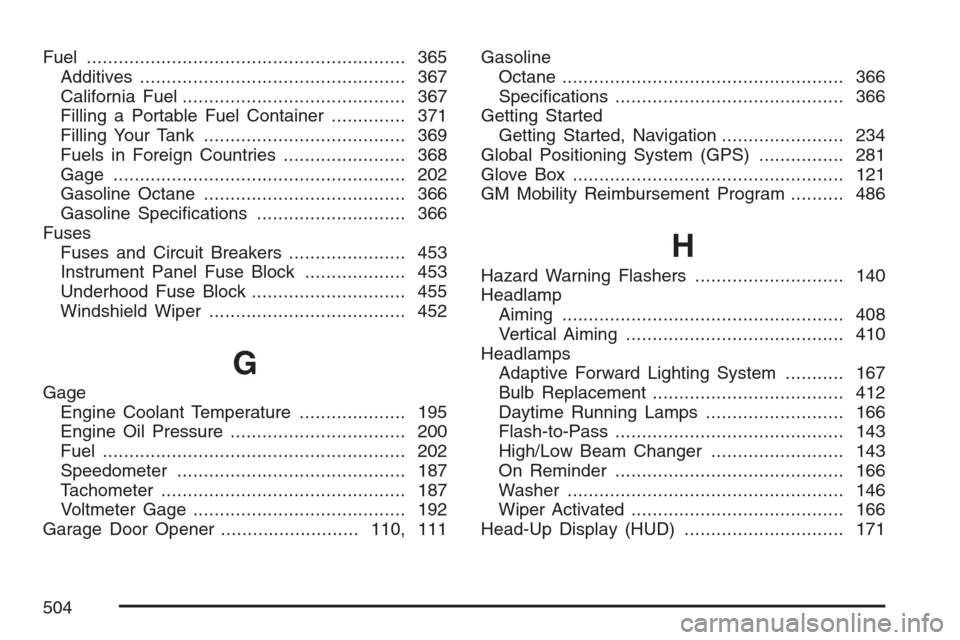
Fuel............................................................ 365
Additives.................................................. 367
California Fuel.......................................... 367
Filling a Portable Fuel Container.............. 371
Filling Your Tank...................................... 369
Fuels in Foreign Countries....................... 368
Gage....................................................... 202
Gasoline Octane...................................... 366
Gasoline Speci�cations............................ 366
Fuses
Fuses and Circuit Breakers...................... 453
Instrument Panel Fuse Block................... 453
Underhood Fuse Block............................. 455
Windshield Wiper..................................... 452
G
Gage
Engine Coolant Temperature.................... 195
Engine Oil Pressure................................. 200
Fuel......................................................... 202
Speedometer........................................... 187
Tachometer.............................................. 187
Voltmeter Gage........................................ 192
Garage Door Opener..........................110, 111Gasoline
Octane..................................................... 366
Speci�cations........................................... 366
Getting Started
Getting Started, Navigation....................... 234
Global Positioning System (GPS)................ 281
Glove Box................................................... 121
GM Mobility Reimbursement Program.......... 486
H
Hazard Warning Flashers............................ 140
Headlamp
Aiming..................................................... 408
Vertical Aiming......................................... 410
Headlamps
Adaptive Forward Lighting System........... 167
Bulb Replacement.................................... 412
Daytime Running Lamps.......................... 166
Flash-to-Pass........................................... 143
High/Low Beam Changer ......................... 143
On Reminder........................................... 166
Washer.................................................... 146
Wiper Activated........................................ 166
Head-Up Display (HUD).............................. 171
504
Page 505 of 512

Heated Seats.................................................. 9
Heater......................................................... 178
Highbeam On Light..................................... 202
Highway Hypnosis....................................... 346
Hill and Mountain Roads............................. 347
Hood
Checking Things Under............................ 372
Release................................................... 373
Horn............................................................ 140
How to Use This Manual................................ 4
How to Wear Safety Belts Properly............... 18
I
Ignition Positions........................................... 88
Infants and Young Children, Restraints.......... 31
In�ation - Tire Pressure............................... 422
Instrument Panel
Overview.................................................. 138
Instrument Panel (I/P)
Brightness................................................ 170
Cluster..................................................... 186
J
Jump Starting.............................................. 403
K
Keyless Access System........................ 67, 280
Keyless Access System, Operation................ 68
Keys............................................................. 65
L
Labeling, Tire Sidewall................................. 415
Lamps
Battery Run-Down Protection................... 171
Courtesy.................................................. 170
Exterior.................................................... 164
Exterior Lighting Battery Saver................. 169
Fog .......................................................... 168
Reading................................................... 171
Twilight Sentinel
®..................................... 168
LATCH System
Child Restraints......................................... 39
Lifting Your Vehicle, Tires............................ 435
Light
Airbag Readiness..................................... 188
Anti-Lock Brake System Warning............. 193
Brake System Warning............................. 192
Charging System..................................... 191
Fog Lamp................................................ 201
Highbeam On.......................................... 202
505
Page 506 of 512

Light (cont.)
Lights On Reminder................................. 202
Malfunction Indicator................................ 196
Passenger Airbag Status Indicator............ 189
Safety Belt Reminder............................... 187
Security................................................... 201
TCS Warning Light.................................. 194
Tire Pressure........................................... 196
Traction Control System (TCS)
Warning................................................ 194
Lighting
Entry/Exit................................................. 170
Limited-Slip Rear Axle................................. 331
Loading Your Vehicle................................... 354
Lockout Protection......................................... 77
Locks
Automatic Door Lock................................. 76
Door.......................................................... 73
Lockout Protection..................................... 77
Power Door............................................... 75
Programmable Automatic Door Unlock....... 76
Loss of Control........................................... 337
Lowering the Retractable Hardtop................ 124
Lumbar
Power Controls............................................ 9M
Magnetic Ride Control................................. 331
Maintenance Schedule
Additional Required Services.................... 467
At Each Fuel Fill...................................... 470
At Least Once a Month............................ 471
At Least Once a Year.............................. 471
Introduction.............................................. 462
Maintenance Footnotes............................ 469
Maintenance Record................................ 477
Maintenance Requirements...................... 462
Normal Maintenance
Replacement Parts............................... 475
Owner Checks and Services.................... 470
Recommended Fluids and Lubricants....... 473
Scheduled Maintenance........................... 465
Using....................................................... 463
Your Vehicle and the Environment............ 462
Malfunction Indicator Light........................... 196
Map Pocket................................................. 122
Maps........................................................... 271
Memory Point, Edit...................................... 250
Memory Seat, Mirrors, Steering Wheel
Controls..................................................... 10
Menu
Setup....................................................... 243
506